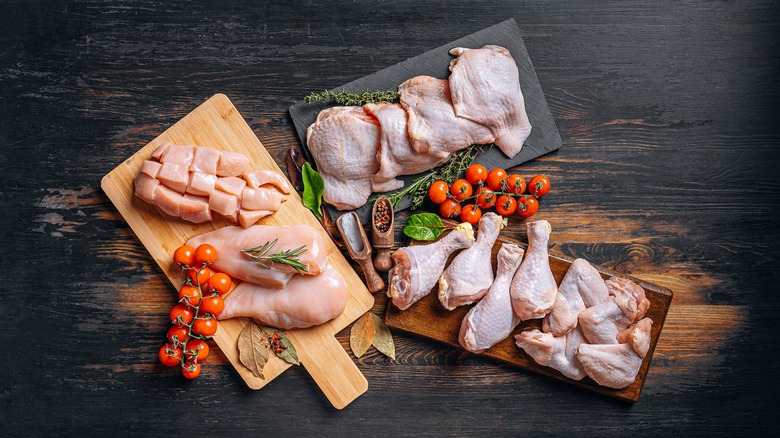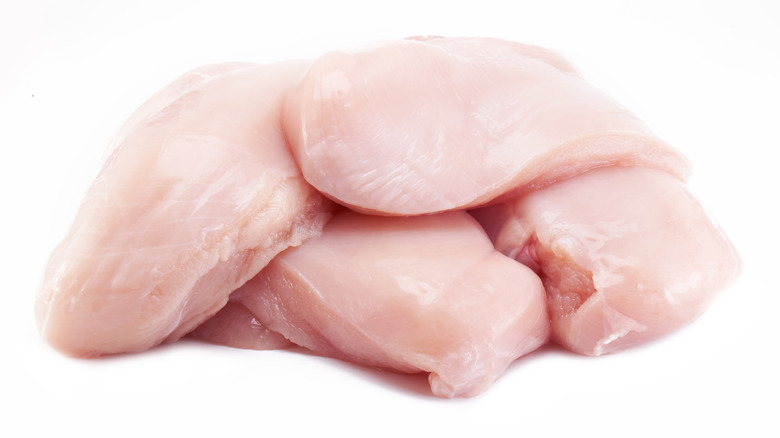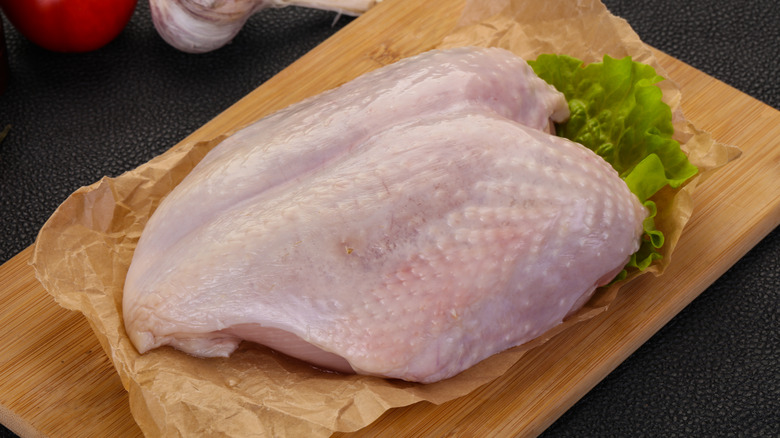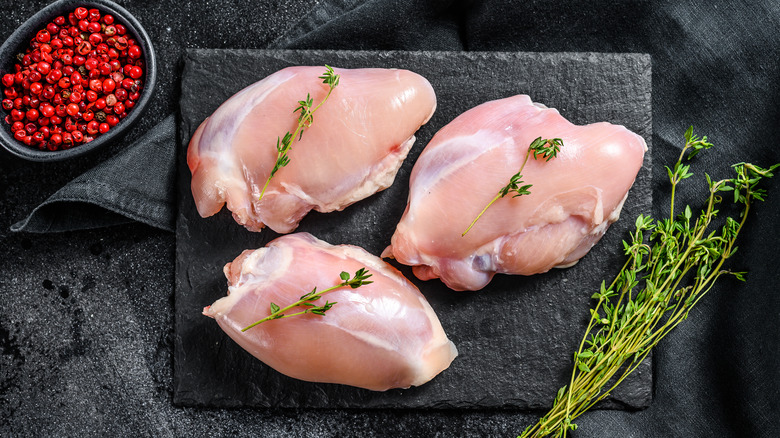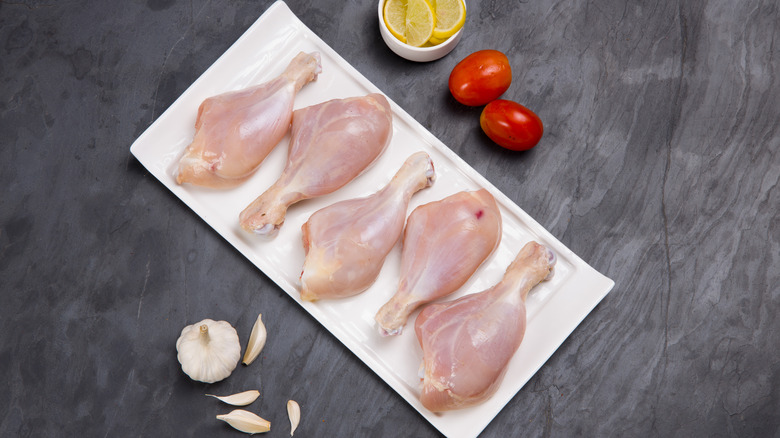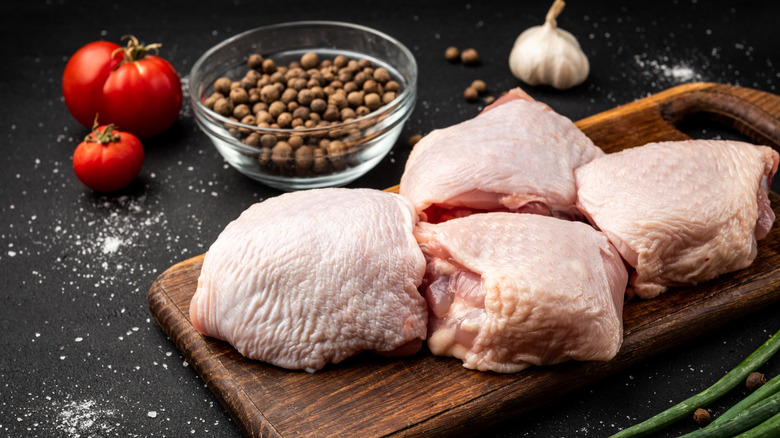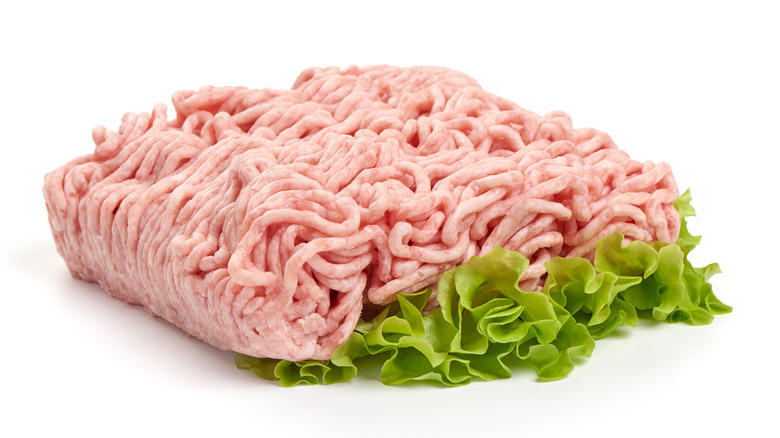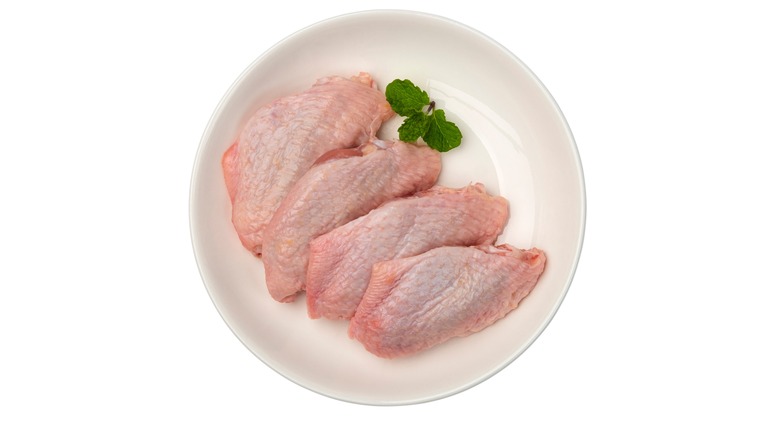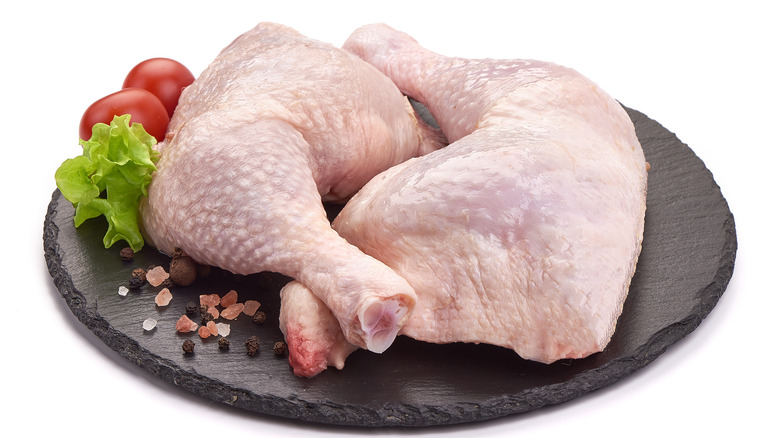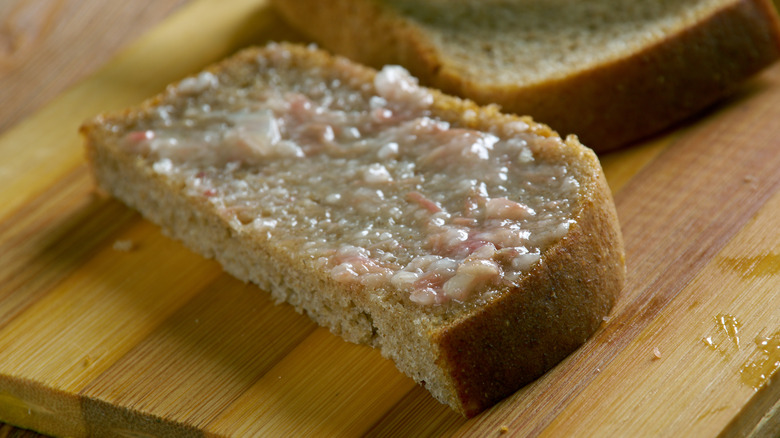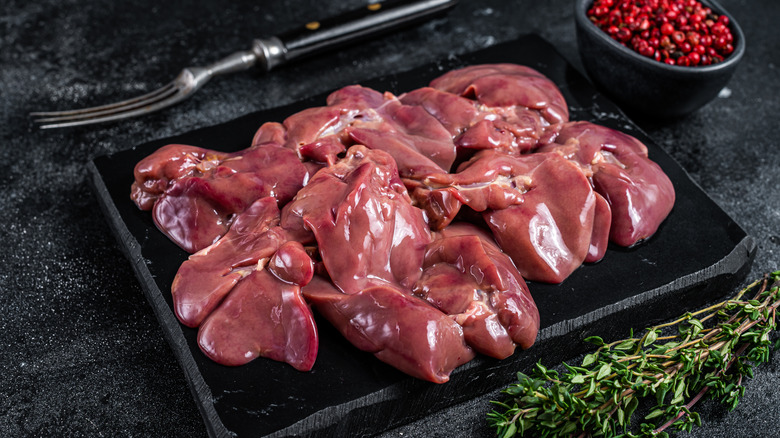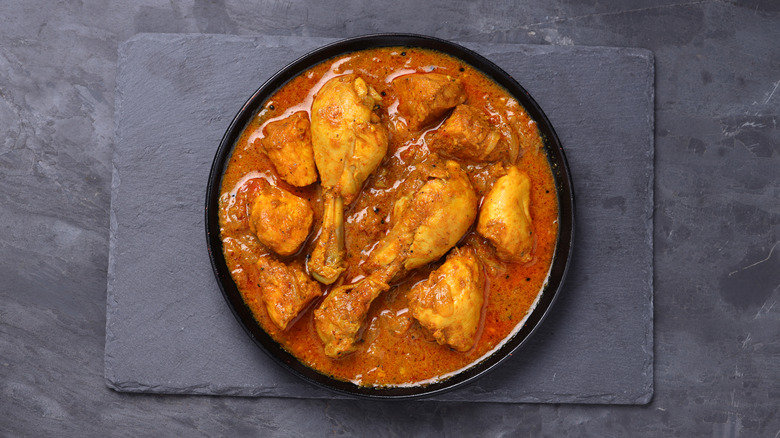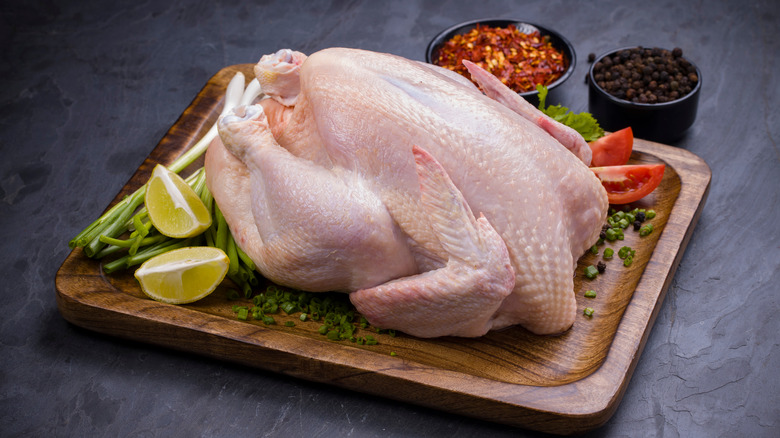Ranking The Cuts And Parts Of Chicken From Worst To Best
In the United States, we eat a lot of meat, including beef, pork, and fish. But if there's one kind of meat to rule them all, it has to be chicken. According to the USDA, chicken is the most-consumed meat in the U.S., and it shouldn't come as a surprise — you can grab a grilled chicken sandwich, a roasted quarter, or fried tenders just about anywhere from the grocery store to your favorite restaurant.
But as much as we love chicken, we tend not to love every part of the bird. Some parts of the chicken, like the liver and excess fat, for instance, are often thrown away, going to waste, while more-popular cuts of the meat, like the breast, are venerated. But why? And which cuts of chicken actually taste the best?
We've done a deep dive to take a close look at notable cuts and parts of chicken, and we've ranked them from worst to best. You may be surprised at where some cuts end up on this list. If there are some cuts that you have yet to try, keep an open mind and head to your local grocery store or butcher shop. Going for a less common (and sometimes less expensive) cut of chicken may just change the way you look at poultry forever.
12. Chicken breast
Coming in last place is what Jamie Oliver calls "arguably the most popular part of a chicken" — but it also happens to be one of the least flavorful and least enjoyable parts as well. It's the chicken breast, and it's probably what you grab when you head to the meat section of your local grocery store and don't know what else to pick up. It may be a favorite of gym bros who bow at the altar of high-protein, unseasoned poultry, but if you ask us, it's a total waste of your money. If chicken breast is one thing, it's dry. Of course, there are plenty of tips and tricks you can employ to make your chicken breasts taste less mouth-drying, but ultimately, it's time for us as a society to come to the conclusion that chicken breasts just don't taste that good.
Chicken breast is known for being a lower-fat meat (via Healthline), so the dietary fat-phobic food culture of the '90s might be to blame. Whatever the case may be, we now know that fat in meat is actually a good thing when it comes to adding flavor to a dish. Therefore, the chicken breast earns its last-place status.
11. Split chicken breast
Now, we're still not huge fans of chicken breast in any form, but if you do insist on opting for the breast, we suggest that you choose a split chicken breast. If you're not familiar with this cut, it's simply a chicken breast with the bones and skin still attached. That bone does the important job of preventing your chicken breast from cooking too fast and keeping moisture in the cut of meat. Since chicken breasts are already notoriously dry, it's clearly a benefit to throw the bones into the pan or oven as well.
And then you've got the skin, which is, in our opinion, the best part of any cut of chicken. Well-cooked chicken skin gets nice and crispy, and if you're cooking it right, it's covered in herbs and spices. So, even if you're dealing with a less-than desirable cut of meat like a chicken breast, you still get some of the benefits you won't find in a boneless, skinless situation. We still don't love split chicken breast, but it's definitely better than its blander. streamlined cousin.
10. Boneless chicken thighs
If you want to go for a widely available cut of chicken, you'd be smart to choose boneless chicken thighs. You can find them in most stores that carry raw chicken. If chicken thighs are cooked well, they are one of the juiciest, most luscious types of meat you can enjoy. However, boneless chicken thighs especially can sometimes become tough if they're not cooked to perfection. It's easier to mess up a chicken breast because it's drier, but it's certainly not unheard of to overcook a boneless thigh either.
Also, if you're trying to watch how much fat you consume, you might want to think carefully about eating thighs on the regular. They contain significantly more fat than breasts (via Eat Right), which, for some, can have negative health consequences. On the other hand, all that fat makes chicken thighs taste richer and fattier, so it's up to you to decide what's more important for your meal.
9. Chicken wing drumettes
Chicken wings are one of those foods that are pretty much always hit the spot no matter what. But it's no secret that wing-eaters have their opinions about which types of wings are better. And here at Tasting Table, we must admit that we are, in fact, flats lovers. Now, are chicken wing drumettes bad? Not by any stretch of the imagination. A cute handheld drumstick doused in buffalo sauce or crisped to perfection? Magical. Transcendent. Life-affirming. How can you not love a fried tiny food? But unfortunately, it's just too hard to get every little piece of meat off of a drumette without getting buffalo sauce all over your face.
Perhaps if you're the type of person who's never been accused of being a messy eater, who barely has to use their napkin when they eat wings, you don't have this problem and can consume your drumettes with joy. But for the rest of us, eating drumette chicken wings in public is just too perilous.
8. Bone-in chicken thighs
What sets bone-in thighs apart from their easier-to-handle boneless counterparts? Well, it all comes down to the fact that including the total package helps to improve the taste. All the flavor that's housed in the chicken bone gets released into the chicken flesh when you cook it — when you divorce the thigh from the bone, you miss out on all of that flavor. Plus, there's that fact that the bone prevents the thigh from drying out, which is especially important if you're not a total pro at cooking chicken.
Are bone-in chicken thighs a bit more difficult to handle on your plate? Sure. You have to contend with the bones and figure out how to cut around them to get the perfect bite onto your fork. But if you ask us, it's worth the extra time and effort to enjoy more of that flavor. Life's too short to throw away the bone, you know?
7. Ground chicken
Let's face it: Inflation is hitting us in the pockets just about everywhere, but it's particularly noticeable when you go to the grocery store. According to Fortune, the annual inflation rate from June 2021 to June 2022 was 9.1%. But when it comes to food, we're technically spending 12.2% more than we did last year. That's a huge jump in prices. And when you're trying to make your dollar stretch, it's important to look for some lower-cost items at the grocery store.
That's one of the reasons we love ground chicken so much: Often, it's cheaper than other cuts of chicken you'll find at the grocery store, which makes it a great budget buy. Plus, it's just so versatile — you can use it in pretty much any recipe that calls for ground beef.
Yes, it can get dry, which is why it doesn't rank higher on our list. It's important to cook your ground chicken on a lower setting than you would typically use for ground beef, as chicken contains less fat. Of course, you can always add olive oil to add more fat to your dish as well, which will combat that dryness.
6. Chicken wing flats
Here come the stars of the casual get-together: chicken wing flats. Wings are, of course, one of the world's perfect foods, but if you want to get the most out of your wing-eating experience, you'll opt for the flats every time. You get more of that crispy skin we all love and why we order wings in the first place. Plus, flats are better able to hold onto sauce than drums are.
Some novice wing eaters may have a problem getting all the meat off of a flat, but once you learn the trick of popping the bones out of the meat, you'll see that it's actually super easy to access all the good stuff. They offer all the ease of eating a boneless wing without having to contend with the dryness that often afflict boneless wings.
You don't have to agree with us here — people who love drums and people who love flats are the perfect wing-eating partners. But deep down, we'll never really understand you drums lovers. We guess that's okay ... let's celebrate our differences.
5. Chicken leg quarters
What if you simply can't make up your mind about what cut of chicken you want? If you are waffling back and forth about whether to go for thighs or drumsticks, we have a solution for you: chicken leg quarters. You may not be able to find this cut everywhere, but once you try it out, you'll realize that it's truly one of the best cuts out there. This is an especially great cut of chicken because it's generally not too expensive. But even though you're not paying much for it doesn't mean it's lacking in taste. Because it's sold both bone-in and skin-on, you're getting a lot more flavor than you would with other cuts.
If you're not seeing the phrase "chicken leg quarters" when you're browsing through the chicken section at your local grocery store, you may want to look for the term "whole chicken legs" instead. Whatever you call them, they're a fantastic cut of chicken that you should check out the next time you're shopping for cost-effective dinner ingredients.
4. Schmaltz
It may not be easy to find at a big-box grocery store, but if you want to enjoy one of the fattiest, richest "cuts" of chicken around, you have to search for schmaltz. Never heard of it before? It's just repurposed chicken fat, a rich liquid that can add a ridiculous amount of salty, savory flavor to whatever dish you add it to. It's an intense gold color that looks almost as good as it tastes. It's frequently used in Eastern European and Jewish dishes, and it can be compared to duck fat or lard, if you've ever used those ingredients before.
Sure, schmaltz may not be a traditional "cut" of chicken, but we'll take any opportunity to sing its praises. While repurposed fat isn't necessarily going to be the centerpiece of your meal (unless you spread it on a thick piece of toast — highly recommended), it's an exciting, versatile ingredient that you should be using if you want to enjoy the best chicken has to offer. Use it as a cooking medium to add a layer of richness to your dish, or utilize it in place of butter. Oh, and since it's dairy free, it can be a great option for people with allergies or dairy sensitivities. The best part? If you're able to find it, you're not likely to pay much for it.
3. Chicken liver
Offal may not be the first thing then comes to mind when you think of the best that chicken has to offer but hear us out: If you know how to cook chicken livers well, you may just find that it's one of the most delicious cuts of chicken you've ever had the pleasure of eating. If you want to keep things simple, opt for baked chicken livers, or if you want to try something that feels a bit more luxurious, opt for this recipe for chicken liver pate with dill-pickled green beans. Both recipes highlight the appealing silky texture of chicken liver while providing just enough seasoning and texture to keep things interesting.
No matter how you eat your chicken liver, though, you'll be happy to know that it's a healthy choice: According to WebMD, chicken liver is a superfood, packed with nutrients like Vitamin A, Vitamin B12, and riboflavin. These nutrients can help support organ health and may even be able to prevent some types of disease. And chicken liver is good for the earth too. Food Navigator notes that eating offal, or organ meats, like liver can be positive for the environment because it helps reduce food waste. (After all, if nobody eats those organ meats, they just get thrown away — not exactly a smart use of resources.) It's time to put your prejudices aside and try chicken liver.
2. Drumsticks
What's not to love about a drumstick? First of all, we love the fact that drumsticks are so cost-effective: When it comes to how much meat you actually get for your money, it's hard to beat the drumsticks. Even as we face intense inflation at the grocery store, you may find that they are one of the more affordable meat options available. And while drumsticks tend to be on the tougher side, they also pack a lot more flavor than, say, a chicken breast. This is because of two factors: skin and fat. That skin can crisp up and give you an extra measure of texture, while the bone will add flavor and prevent the meat from drying out too much.
Plus, drumsticks are fantastic because they are so, so versatile. Throwing them in the oven to bake is an easy way to get dinner on the table fast, but you could also bread them and make luscious, juicy fried chicken. (Our take is that drumsticks are the absolute best cut for fried chicken, and nobody will ever change our minds.) Take them out to the grill for a summertime feast, or cook them in a soup or a stew before removing the bones. In fact, if you're at a loss for what to make for dinner tonight, you should probably head to the store and pick up some chicken drumsticks ASAP.
1. Whole chicken
Finally, we've reached the best cut of them all: the whole chicken. Does buying a whole chicken involve more of an upfront investment? Of course. Is it slightly more difficult to prepare than the individual pieces? Some would argue so. But is getting the entire bird almost always better than just opting for a breast, a thigh, or even a drumstick? In our opinion, absolutely. First of all, you're going to save some money if you go this route, as buying a whole chicken is almost always less expensive than buying its individual parts per pound, and it makes sense considering that it takes less labor to produce — nobody has to be paid to break it down.
But it's not just about the price. Cooking a whole chicken is the best way to make sure everyone at the table is satisfied because everybody gets to take the piece they love most. You won't have to succumb to the light meat versus dark meat debate, and that itself is worth the extra work a whole chicken makes. (Of course, don't sleep on the skin!) Then, when all the meat has been picked off the bones, you can use the carcass for an easy chicken soup recipe.
If you don't feel like cooking a whole chicken yourself, you can always pick up an inflation-proof Costco rotisserie chicken or spend a bit more at your local supermarket for an easy weeknight meal.
